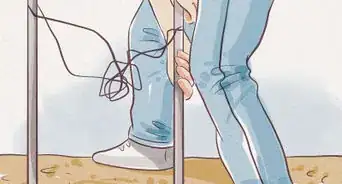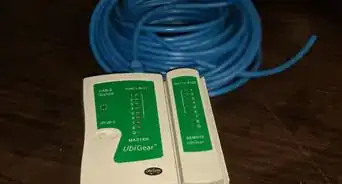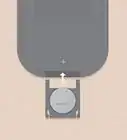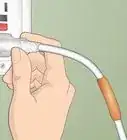This article was co-authored by Ricardo Mitchell and by wikiHow staff writer, Devin McSween. Ricardo Mitchell is the CEO of CN Coterie, a fully licensed and insured Lead EPA (Environmental Protection Agency) Certified construction company located in Manhattan, New York. CN Coterie specializes in full home renovation, electrical, plumbing, carpentry, cabinetry, furniture restoration, OATH/ECB (Office of Administrative Trials and Hearings/Environmental Control Board) violations removal, and DOB (Department of Buildings) violations removal. Ricardo has over 10 years of electrical and construction experience and his partners have over 30 years of relevant experience.
There are 10 references cited in this article, which can be found at the bottom of the page.
wikiHow marks an article as reader-approved once it receives enough positive feedback. In this case, several readers have written to tell us that this article was helpful to them, earning it our reader-approved status.
This article has been viewed 366,281 times.
One of the best ways to protect your home from lightning strikes or electrical shorts is to put in ground rods. Ground rods create a route for stray electricity to travel on, taking the electricity out of your house and into the ground. Luckily, it’s easy to install ground rods all by yourself with just a bit of planning and care. In this article, we’ll show you how to choose a location for your ground rod, how to drive it into the ground, and how to connect it to your electrical panel. Read on to learn how to install your ground rods!
Things You Should Know
- Find a place for your ground rod outside that’s near your home’s electrical panel and at least 2 feet (0.61 m) away from the side of your house.
- Dig a 2–4 feet (0.61–1.22 m) deep hole and insert the rod inside. Drive it all the way into the ground with a hammer, driving drill bit, or post driver tool.
- Connect a 4-gauge copper wire, called the grounding electrode conductor, to the rod with a ground rod clamp.
- Drill a hole in the wall to route the conductor to your electrical panel. Connect the conductor to the ground bus bar where your ground and neutral wires are located.
Steps
Picking a Location for the Rod
-
1Install the rod outside and close to your home’s electrical panel. To install a ground rod, you hammer it about 8 feet (2.4 m) deep into the ground outside. You connect the rod to your home’s electrical panel, so choose an area for the rod that’s near the panel. Make sure the spot is convenient to get to and has enough space for you to use tools to drive the rod into the ground.[1]
- Keep the ground rod at least 2 feet (0.61 m) from the side of your house. This prevents the ground rod from hitting the foundation.[2]
-
2Plan the route for the grounding electrode conductor. Once you install the ground rod, you connect it to the electrical panel inside with a copper wire called the grounding electrode conductor. Plan out the conductor’s path to make sure it easily runs from the ground rod to your electrical panel. Then, measure the distance of the path to see how much wiring you need.[3]
- You typically have to drill a hole in the wall to run the conductor from the rod to your electrical panel inside. The conductor is about 0.2 inches (0.5 cm) thick, so make a hole at least 0.5 inches (1 cm) wide to fit the conductor through.
Advertisement -
3Choose a spot for the rod that isn’t rocky or heavily compacted. Because you’re driving the rod 8 feet (2.4 m) into the ground, avoid areas that are rocky. Instead, pick an area in your yard that is full of loose, soft soil. This helps your rod go into the ground more smoothly and makes installation quicker.
-
4Call your utility company to locate any ground wires before you dig. In most countries, there are free hotlines for you to call that locate the underground utility lines, cables, and pipes in your yard. In the US, call 811 or go to your state’s 811 dig website to request a utility operator to mark the ground wires on your property.[4]
- It usually takes about 2 to 3 days for the utility operator to come to your home and locate the wires.
- If there is no hotline in your area, call your utility company directly and ask them to locate their underground lines.
Inserting the Rod into the Ground
-
1Purchase a listed ground rod verified for use by a certification group. Ground rods are made of specific conductive metals and have a required length and width to work effectively. Only buy ground rods that are specifically made for grounding an electrical system. These rods are called listed, which means that they are verified for use by a certification group, such as Underwriters Laboratories. Using listed rods ensures that it is the correct size and material. Most home improvement and hardware stores stock approved grounding rods.[5]
- High-quality grounding rods are typically made of high carbon steel because of its durability. They’re also electro-plated with copper for its conductivity and longevity.[6]
- In the US, listed ground rods are at least 8 feet (2.4 m) long and 1⁄2 inch (1.3 cm) wide. If the rod is not listed, they need to be at least 5⁄8 inch (1.6 cm) wide.[7]
- A listed ground rod has a marking near the top that states that it is approved for grounding use. The mark lets an electrical inspector know that you used an approved rod.
- Currently, most electrical codes require you to add 2 ground rods at least 6 feet (1.8 m) apart if your ground resistance is greater than 25 ohms. Use a ground meter or earth electrode tester to measure the ground’s resistance and determine if you need to install more than 1 ground rod.[8]
-
2Dig a hole about 2–4 feet (0.61–1.22 m) deep and 6 inches (15 cm) wide. To make installing the ground rod easier, dig a hole 2–4 feet (0.61–1.22 m) deep and 6 inches (15 cm) wide with a shovel. Or, use a post-hole digger. This gives you more leverage on top of the rod and makes it easier to hammer into the ground.
- If you don't want to dig a hole, stand on top of a ladder or step stool to get enough height and leverage to pound the top of the ground rod.
-
3Use a hammer to drive the rod all the way into the ground. Most electrical codes state to drive the ground rod 8 feet (2.4 m) deep into the ground. Simply place the pointed end of the ground rod into the hole you dug. Then, stand over the rod and use a hammer or mallet to gradually drive the rod vertically into the ground. For a faster installation, add a driving tool attachment to a drill or use a post driver tool to insert the rod into the soil.[9]
- Search for your state’s electrical codes online to see how deep to drive the ground rod. Some electrical inspectors require the entire rod to be underground, while others allow you to leave 1–2 inches (2.5–5.1 cm) sticking up out of the ground.
- Pour water into the hole to soften the soil and make driving the rod into the ground faster. If you saturate the ground with water, you might find it easier to simply push the rod into the ground without any tools.[10]
- Get a friend or family member to help you drive the rod into the ground. Ask them to hold the rod straight as you hammer. If you start to get tired, ask them to hammer as you hold the rod.
Connecting the Rod to the Electrical Panel
-
1Pull the grounding electrode conductor to the ground rod. Now that your ground rod is in the ground, you need to connect it to your home’s electrical system. Take your grounding electrode conductor and pull it to the top of the grounding rod. Make sure the conductor is long enough to connect between the rod and the electrical panel.[11]
- Most electrical codes require you to use a 4-gauge copper wire as your grounding electrode conductor.
- Give the grounding conductor a little bit of slack so it's not extremely tight where it connects with the grounding rod. This ensures that it won’t get dislodged from the grounding rod if it gets hit or pushed on.
- If you aren’t using a bare copper wire, cut off the last 1⁄2 inch (1.3 cm) of the casing to expose the wire.
-
2Attach the grounding electrode conductor to the rod with a clamp. Take a ground rod clamp and place it over the top of the ground rod. Then, pull the grounding electrode conductor up through the clamp. Turn the screw on the side of the clamp to tighten the clamp and conductor to the rod.[12]
- Ground rod clamps are sold in most home improvement and hardware stores.
-
3Turn off the electric panel and secure the conductor to the ground bus. Shut off all the breakers in the panel to protect yourself from any electrical shocks. Then, feed the grounding electrode conductor through the hole you drilled in the wall and pull it to your electrical panel. Open your panel and find the ground bus; this is the bar where all the ground and neutral wires attach to the electrical panel. To make the connection with the conductor, slide the end of it through one of the holes in the bus. Then, tighten the screw with a screwdriver to secure the wire inside the hole.[13]
- In some cases, the ground wires are connected to the ground bus and the neutral wires are connected to the neutral bus. These 2 bars are then connected with a main bonding jumper. If your panel is set up like this, attach the conductor wherever it fits on either bus.[14]
- Work very carefully when attaching the conductor. Make sure that your fingers, tools, and the grounding electrode conductor don't make contact with the energized bars in the panel, which are located behind the circuit breakers.
- Hire an electrician to do this work if you feel unsure how to make the connection yourself.
-
4Call an electrical inspector to ensure your work is up to code. Most states require that you get electrical work looked over by an inspector. So, before you cover up your ground rod and clean up your work area, hire a local electrical inspector to check out your installation. They’ll make sure you used the appropriate ground rod and correctly grounded your grounding electrode conductor to the rod and your electrical panel.[15]
- After the inspector approves your work, bury the exposed grounding electrode conductor under the ground or cover it with a conduit pipe.
- Apply caulk around the hole you drilled in the wall to close it up. Or, spray the hole with spray foam.
Expert Q&A
-
QuestionWhat material should my ground rods be made of?
 Ricardo MitchellRicardo Mitchell is the CEO of CN Coterie, a fully licensed and insured Lead EPA (Environmental Protection Agency) Certified construction company located in Manhattan, New York. CN Coterie specializes in full home renovation, electrical, plumbing, carpentry, cabinetry, furniture restoration, OATH/ECB (Office of Administrative Trials and Hearings/Environmental Control Board) violations removal, and DOB (Department of Buildings) violations removal. Ricardo has over 10 years of electrical and construction experience and his partners have over 30 years of relevant experience.
Ricardo MitchellRicardo Mitchell is the CEO of CN Coterie, a fully licensed and insured Lead EPA (Environmental Protection Agency) Certified construction company located in Manhattan, New York. CN Coterie specializes in full home renovation, electrical, plumbing, carpentry, cabinetry, furniture restoration, OATH/ECB (Office of Administrative Trials and Hearings/Environmental Control Board) violations removal, and DOB (Department of Buildings) violations removal. Ricardo has over 10 years of electrical and construction experience and his partners have over 30 years of relevant experience.
Electrician & Construction Professional, CN Coterie Graph and ground rods are made of copper, because it's durable and it's a strong conductor.
Graph and ground rods are made of copper, because it's durable and it's a strong conductor.
Warnings
- It's important to ground all electrical systems. Grounding can prevent electrical fires and injuries by giving uncontrolled electricity a route to the ground, rather than through a property or people.[16]⧼thumbs_response⧽
Things You'll Need
- Ground rod
- Ground rod clamp
- Grounding electrode conductor (#4 AWG copper wire)
- Sledgehammer, hammer drill with a ground rod bit, or a manual post driving tool
- Shovel or post-hole digger
- Screwdriver
- Drill
- Hammer
References
- ↑ https://iaeimagazine.org/magazine/2006/03/16/ground-rod-electrodes-what-you-need-to-know/
- ↑ https://youtu.be/Da3niHV1v-Q?t=193
- ↑ https://iaeimagazine.org/magazine/2006/03/16/ground-rod-electrodes-what-you-need-to-know/
- ↑ http://call811.com/before-you-dig/how-811-works
- ↑ http://www.adamselectric.coop/wp-content/uploads/2015/02/Grounding-Bonding.pdf
- ↑ Ricardo Mitchell. Electrician & Construction Professional, CN Coterie. Expert Interview. 6 May 2020.
- ↑ https://iaeimagazine.org/magazine/2006/03/16/ground-rod-electrodes-what-you-need-to-know/
- ↑ https://www.csemag.com/articles/electrical-grounding-and-bonding-per-nec/
- ↑ https://iaeimagazine.org/magazine/2006/03/16/ground-rod-electrodes-what-you-need-to-know/
- ↑ https://youtu.be/ML9Ga_ud5fY?t=32
- ↑ http://www.adamselectric.coop/wp-content/uploads/2015/02/Grounding-Bonding.pdf
- ↑ http://www.adamselectric.coop/wp-content/uploads/2015/02/Grounding-Bonding.pdf
- ↑ http://www.adamselectric.coop/wp-content/uploads/2015/02/Grounding-Bonding.pdf
- ↑ https://www.ecmag.com/section/codes-standards/connecting-grounding-electrode-conductor-protecting-copper-and-more
- ↑ https://www.dli.mn.gov/sites/default/files/pdf/eli_inspection_checklist2.pdf
- ↑ http://www.adamselectric.coop/wp-content/uploads/2015/02/Grounding-Bonding.pdf
About This Article
Before you install ground rods, call your local digging hotline so they can send someone to locate any wires or pipes that are in the path of where you want to put your ground rod. Once you’re sure there are no pipes or wires in the area, purchase an approved grounding rod set. Then, dig a hole 2-4 feet deep where you want to insert the rod. Drive the rod into the ground using a hammer, drill, or driving tool, until it’s all the way in. Once you’ve put the rod in, you’ll need to connect it the electrical system of the building. If you’re not sure how to do this, consider hiring an Electrician who can safely help you complete the process. To learn how to choose a good location for your grounding rod, read on!

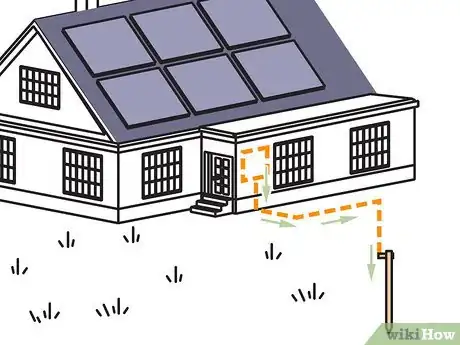
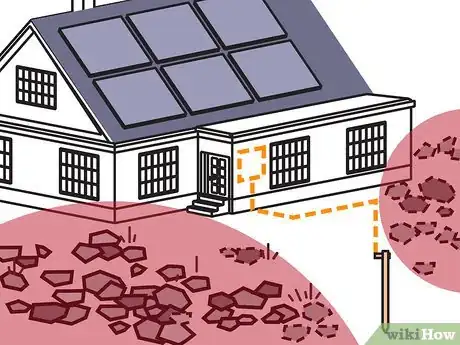
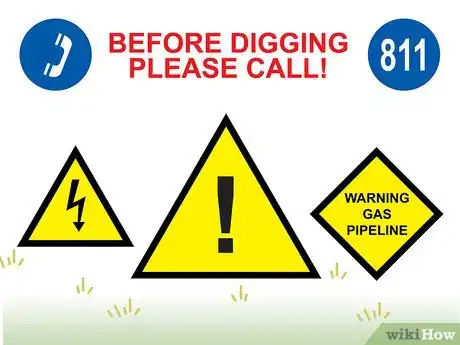
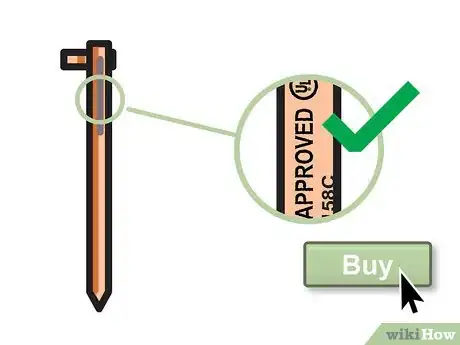



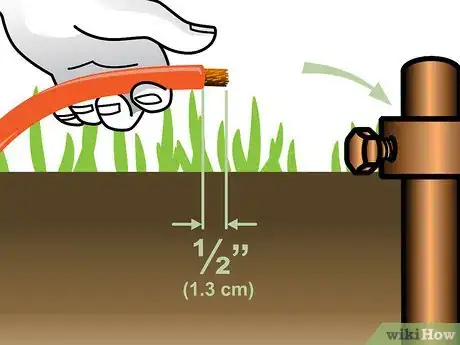
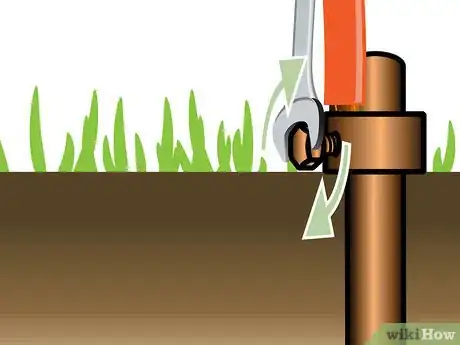

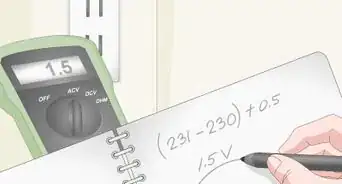
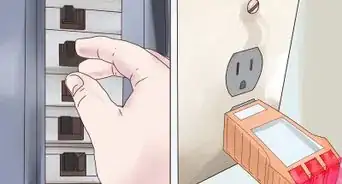

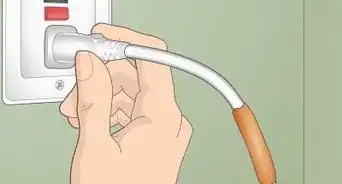


-Electric-Shock-Step-8.webp)


-Step-6-Version-2.webp)
